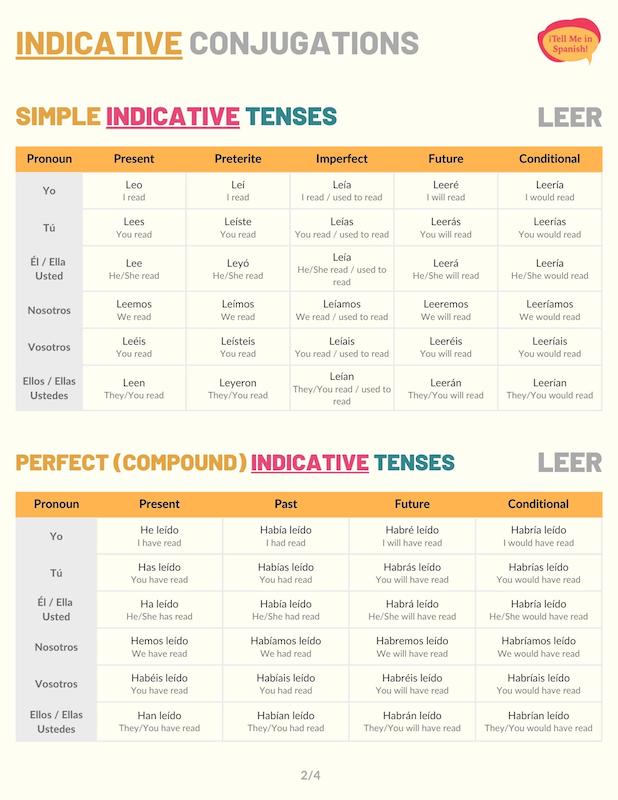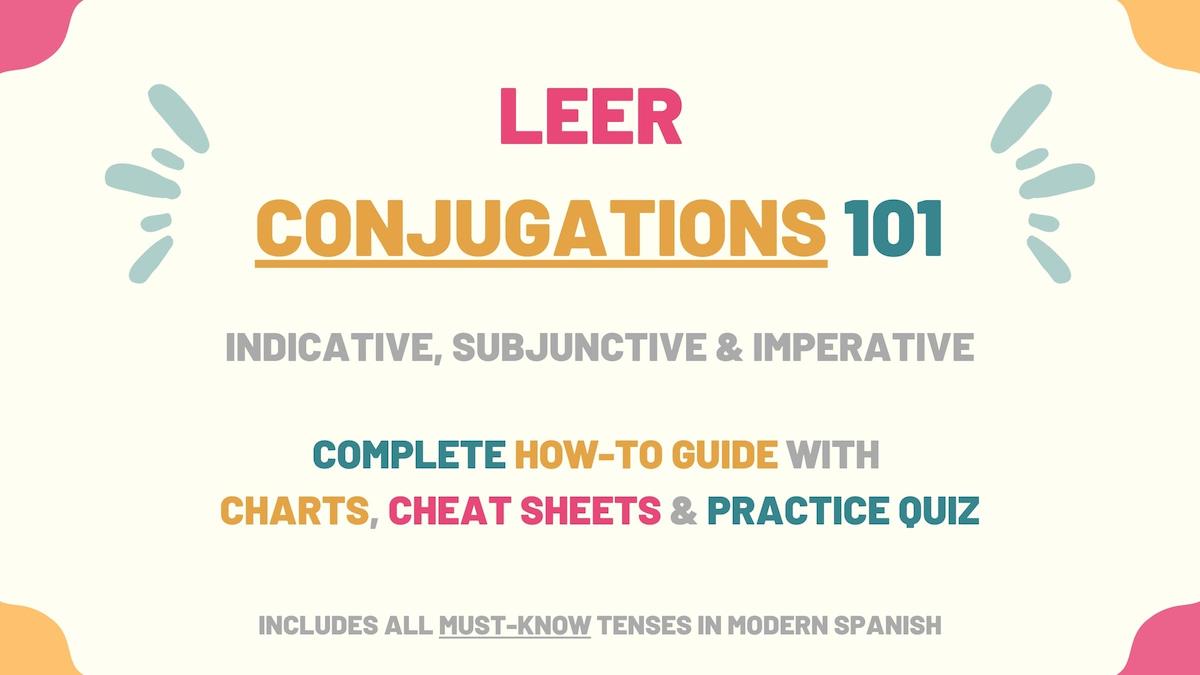Since it’s a common -ER verb with some important spelling changes, leer conjugation patterns are important for you to learn. So, in this guide, we’ll go over how to conjugate leer in the most important Spanish tenses. Here is a summary of what we’ll cover:
- Leer Overview
- Indicative Tenses of Leer Conjugations
- Subjunctive Tenses of Leer Conjugations
- Imperative (Commands) of Leer Conjugations
- Uses & Examples
- Download Leer Conjugation Tables & Uses Cheat sheets
- Leer Conjugation Practice Quiz
Overview of Leer
| Verb Characteristic | Property |
|---|---|
| Verb Type | -ER |
| Irregular | No |
| Infinitive | Leer |
| Gerund (Present Participle) Form | Leyendo |
| Past Participle Form | Leído |
| Synonyms | N/A |
Indicative Conjugations of Leer
Present tense
Leer present tense conjugations don’t have any stem changes. We conjugate this verb to the present tense to talk about someone’s current reading habits or skills. For instance: Sally lee el periódico todos los días.
| Person | Conjugation | Translation |
|---|---|---|
| Yo | Leo | I read |
| Tú | Lees | You read |
| Él / Ella Usted | Lee | He/She reads You (formal) read |
| Nosotros | Leemos | We read |
| Vosotros | Leéis | You read |
| Ellos / Ellas Ustedes | Leen | They read You (plural) read |
Preterite tense
Leer preterite conjugations have a stem change only for the third-person singular and plural. For these subject pronouns, we must use the stem ley. Additionally, the preterite ending for ‘tú’ must be accented. You can see these changes in the leer conjugation chart below.
We use these forms to communicate that people read something in the past. For example: ¿Qué libro leyeron este mes?
| Person | Conjugation | Translation |
|---|---|---|
| Yo | Leí | I read |
| Tú | Leíste | You read |
| Él / Ella Usted | Leyó | He/She read You (formal) read |
| Nosotros | Leímos | We read |
| Vosotros | Leísteis | You read |
| Ellos / Ellas Ustedes | Leyeron | They read You (plural) read |
Take Note: Spanish verbs whose stems end with a vowel will follow the same pattern as leer. Click here to check similar verbs in the preterite tense.
Imperfect tense
Leer imperfect conjugation is regular. We conjugate this verb to the past imperfect tense to talk about people’s past reading habits. You can also use these forms to communicate how or what people used to read. For example: Mi mamá siempre nos leía un cuento.
| Person | Conjugation | Translation |
|---|---|---|
| Yo | Leía | I read I used to read |
| Tú | Leías | You read You used to read |
| Él / Ella Usted | Leía | He/She read He/She used to read You (formal) read You (formal) used to read |
| Nosotros | Leíamos | We read We used to read |
| Vosotros | Leíais | You read You used to read |
| Ellos / Ellas Ustedes | Leían | They read They used to read You (plural) read You (plural) used to read |
Near future
To form the Spanish near or immediate future, use the formula ir (present indicative tense) + a + leer. Conjugate leer to these tenses to express that people are about to read something. For example: Jonathan va a leer un poema.
| Person | Conjugation | Translation |
|---|---|---|
| Yo | Voy a leer | I’m going to read |
| Tú | Vas a leer | You’re going to read |
| Él / Ella Usted | Va a leer | He/She is going to read You (formal) are going to read |
| Nosotros | Vamos a leer | We’re going to read |
| Vosotros | Vais a leer | You’re going to read |
| Ellos / Ellas Ustedes | Van a leer | They’re going to read You (plural) are going to read |
Future simple tense
Conjugate leer to the future simple tense to explain that someone will read something at some point in the future. Algún día leeré ese libro.
| Person | Conjugation | Translation |
|---|---|---|
| Yo | Leeré | I will read |
| Tú | Leerás | You will read |
| Él / Ella Usted | Leerá | He/She will read You (formal) will read |
| Nosotros | Leeremos | We will read |
| Vosotros | Leeréis | You (formal) will read |
| Ellos / Ellas Ustedes | Leerán | They will read You (plural) will read |
Conditional tense
Leer conditional conjugations are regular. We use this verb in the conditional tense to talk about what people would read. For instance: ¿Qué libro no leerían?
| Person | Conjugation | Translation |
|---|---|---|
| Yo | Leería | I would read |
| Tú | Leerías | You would read |
| Él / Ella Usted | Leería | He/She would read You (formal) would read |
| Nosotros | Leeríamos | We would read |
| Vosotros | Leeríais | You would read |
| Ellos / Ellas Ustedes | Leerían | They would read You (plural) would read |
Present perfect tense
To conjugate leer to the Spanish present perfect, use the structure haber (in the present tense) + leído (past participle). When conjugated to the present perfect tense, this verb refers to the things people have or haven’t read. ¿Han leído algo de esta autora?
| Person | Conjugation | Translation |
|---|---|---|
| Yo | He leído | I have read |
| Tú | Has leído | You have read |
| Él / Ella Usted | Ha leído | He/She has read You (formal) have read |
| Nosotros | Hemos leído | We have read |
| Vosotros | Habéis leído | You have read |
| Ellos / Ellas Ustedes | Han leído | They have read You (plural) have read |
Take Note: Spanish verbs like ‘leer’ whose roots end with a vowel must have an accent mark in the past participle ending.
Past perfect
The past perfect in Spanish is formed with the imperfect conjugations of ‘haber’ + past participle form (leído, in this case). We use these forms to communicate that someone had read something before a past action or another reference point in the past.
For example: Cuando llegué, ustedes ya habían leído mi correo.
| Person | Conjugation | Translation |
|---|---|---|
| Yo | Había leído | I had read |
| Tú | Habías leído | You had read |
| Él / Ella Usted | Había leído | He/She had read You (formal) had read |
| Nosotros | Habíamos leído | We had read |
| Vosotros | Habíais leído | You had read |
| Ellos / Ellas Ustedes | Habían leído | They had read You (plural) had read |
Future perfect
Conjugate leer to the future perfect tense to express that someone will have read by or before a certain moment in the future. We also use this verb in this tense to talk about what someone might have read. Para el lunes, habré leído cinco libros.
| Person | Conjugation | Translation |
|---|---|---|
| Yo | Habré leído | I will have read |
| Tú | Habrás leído | You will have read |
| Él / Ella Usted | Habrá leído | He/She will have read You (formal) will have read |
| Nosotros | Habremos leído | We will have read |
| Vosotros | Habréis leído | You will have read |
| Ellos / Ellas Ustedes | Habrán leído | They will have read You (plural) will have read |
Conditional perfect
The conditional perfect conjugations of leer are used to express that someone would have read if a past condition had been met. These conjugations also allow you to hypothesize about what someone read.
For example: ¿Habrían leído ese libro si se los hubiera recomendado Lucía?
| Person | Conjugation | Translation |
|---|---|---|
| Yo | Habría leído | I would have read |
| Tú | Habrías leído | You would have read |
| Él / Ella Usted | Habría leído | He/She would have read You (formal) would have read |
| Nosotros | Habríamos leído | We would have read |
| Vosotros | Habríais leído | You would have read |
| Ellos / Ellas Ustedes | Habrían leído | They would have read You (plural) would have read |
Progressive tenses
The progressive tenses of leer express that someone is reading at the moment of speaking or, in the case of past tenses (preterite and imperfect), to communicate that a past action happened when someone was reading. For example: Estaba leyendo cuando se fue la luz.
The Spanish progressive tenses are conjugated by using the formula estar conjugated + present participle of leer.
| Progressive Tense | Formula | Translation Example |
|---|---|---|
| Present | Estar (present) + leyendo | I am reading |
| Preterite | Estar (preterite) + leyendo | You were reading |
| Imperfect | Estar (imperfect) + leyendo | He was reading |
| Future | Estar (future) + leyendo | We will be reading |
| Conditional | Estar (conditional) + leyendo | They would be reading |
Take Note: Notice that the present participle of leer uses the ending -yendo. We use this present participle ending with verbs whose roots finish in a vowel. You can see a list of verbs that follow this pattern here.
Leer Subjunctive Conjugations
The Spanish subjunctive mood is used to talk about wishes, requests, suggestions, expectations, doubts, or hypothetical situations. In the sections below, you’ll find the leer conjugation charts for the most common subjunctive tenses.
Present subjunctive
Leer subjunctive conjugation is regular. We conjugate this verb to the present subjunctive to request, wonder or wish that a person reads something. For instance: Te sugiero que leas este libro.
| Person | Conjugation | Translation |
|---|---|---|
| Yo | Lea | I read |
| Tú | Leas | You read |
| Él / Ella Usted | Lea | He/She reads You (formal) read |
| Nosotros | Leamos | We read |
| Vosotros | Leáis | You read |
| Ellos / Ellas Ustedes | Lean | They read You (plural) read |
Present perfect subjunctive
Haber in the present subjunctive + leído is how you form the present perfect subjunctive conjugations of leer. Use this tense to wonder, express doubt or wish that someone has already read something. Dudo que hayamos leído tantos libros como Mandy.
| Person | Conjugation | Translation |
|---|---|---|
| Yo | Haya leído | I have read |
| Tú | Hayas leído | You have read |
| Él / Ella Usted | Haya leído | He/She has read You (formal) have read |
| Nosotros | Hayamos leído | We have read |
| Vosotros | Hayáis leído | You have read |
| Ellos / Ellas Ustedes | Hayan leído | They have read You (plural) have read |
Imperfect subjunctive
Leer imperfect subjunctive conjugations are formed with the root leye to keep pronunciation consistent. We use this tense to talk about past suggestions, requests, and wishes someone had about a person reading. Candice nos sugirió que leyéramos a este autor.
In Spanish, there are two ways to conjugate the imperfect subjunctive:
Latin American Spanish version
| Person | Conjugation | Translation |
|---|---|---|
| Yo | Leyera | I read |
| Tú | Leyeras | You read |
| Él / Ella Usted | Leyera | He/She read You (formal) read |
| Nosotros | Leyéramos | We read |
| Ellos / Ellas Ustedes | Leyeran | They read You (plural) read |
Note: Since vosotros is not used in Latin American Spanish, the leer conjugation chart above doesn’t include the conjugation for this pronoun.
Castilian Spanish version
| Person | Conjugation | Translation |
|---|---|---|
| Yo | Leyese | I read |
| Tú | Leyeses | You read |
| Él / Ella Usted | Leyese | He/She read You (formal) read |
| Nosotros | Leyésemos | We read |
| Vosotros | Leyeseis | You read |
| Ellos / Ellas Ustedes | Leyesen | They read You (plural) read |
Past perfect subjunctive
We conjugate leer to the past perfect subjunctive to communicate that someone would have read if a past condition was met. These forms also express regret for something which someone had or hadn’t read. For example: Ojalá no hubieras leído ese mensaje.
| Person | Conjugation | Translation |
|---|---|---|
| Yo | Hubiera leído | I had read |
| Tú | Hubieras leído | You had read |
| Él / Ella Usted | Hubiera leído | He/She had read You (formal) had read |
| Nosotros | Hubiéramos leído | We had read |
| Vosotros | Hubierais leído | You had read |
| Ellos / Ellas Ustedes | Hubieran leído | They had read You (plural) had read |
Leer Imperative Conjugations
The imperative mood, informally known as Spanish commands, is used to give orders to people.
Affirmative commands
To command someone to read, use the affirmative commands conjugations of leer. As shown in the conjugation chart below, this verb is regular in the imperative mood. Here is an example: Lea las instrucciones antes de contestar.
| Person | Conjugation | Translation |
|---|---|---|
| Tú | Lee | Read |
| Usted | Lea | Read |
| Vosotros | Leed | Read |
| Ustedes | Lean | Read |
Negative commands
On the other hand, use the negative commands in Spanish to order someone not to read something. No leáis lo que escribí.
| Person | Conjugation | Translation |
|---|---|---|
| Tú | No leas | Don’t read |
| Usted | No lea | Don’t read |
| Vosotros | No leáis | Don’t read |
| Ustedes | No lean | Don’t read |
Meanings of Leer & Examples
Since we already learned how to conjugate leer in Spanish, below are some examples of how to use this verb. As the direct translation of ‘to read’, this verb is used similarly to its English equivalent.
[Leer conjugated] + [complement]
Sam leería mejor si practicara.
Sam would read better if he practiced.
Nunca había leído un libro tan aburrido.
I had never read such a boring book before.
¿Cuándo van a leer el email que les mandé?
When are you guys going to read the email I sent you?
Take Note: Leer can be combined with nouns when talking about the things someone reads. You can use adverbs of manner to describe how well or bad someone reads.
Download Leer Conjugation Charts & Uses Cheat sheets

I’ve created a PDF of this verb’s cheat sheets you can download which includes all of the leer conjugation tables as well as its stem changes, uses and real-world example sentences.
Practice Quiz: Leer Conjugation

Now that you know how to conjugate leer in Spanish, consider taking the leer conjugation practice quiz to test your knowledge of this verb’s various forms and memorize its stem changes.



